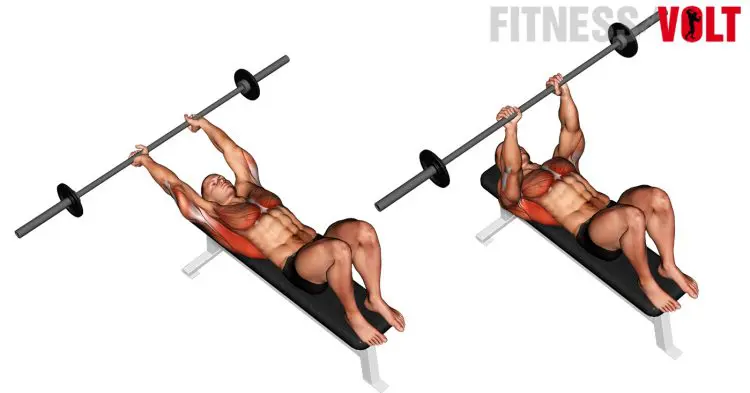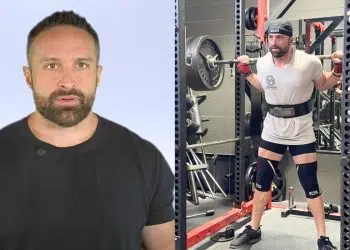The cable straight arm pulldown (with rope) is an exercise that we highly recommend not just because it’s an effective lat builder, but because it increases scapular strength and stability. This is crucial for being able to maintain a safe and string lifting posture when it comes to performing the multi-joint, compound lifts such as deadlifts, pull-ups, squats, and bench presses.
In this article, we’ve explained how to do this exercise with tips, variations, and some information on how to include it in your training regime.
Here’s a guide to the cable straight arm pulldown (with rope)…
In This Exercise:
- Target Muscle Group: Latissimus dorsi
- Type: Stability, strength, and function
- Mechanics: Isolation
- Equipment: Cables, rope attachment
- Difficulty: Beginner
Muscles Worked
Below we’ve provided a small description of each muscle group involved in this exercise.
Latissimus dorsi
The point of straight arm pulldowns is to strengthen and reinforce the function of the latissimus dorsi or lat muscles. Lats are a crucial pulling and performance based muscles. For example, lifters typically include them to improve their deadlift performance. Therefore, unlike other muscles we should include similar movements to reinforce lat activation.
The lats anatomically are a “pull” muscle and because of its pure size and width, it’s also a powerful muscle.
Level Up Your Fitness: Join our 💪 strong community in Fitness Volt Newsletter. Get daily inspiration, expert-backed workouts, nutrition tips, the latest in strength sports, and the support you need to reach your goals. Subscribe for free!
Deltoid Posterior
An underrated muscle due to its lack of easy visibility on the rear part of the shoulder, the deltoid posterior is an important muscles for movements that pull back the scapula and draw the arms rearward behind the body.
Teres Major
Attached to the shoulder joint and shoulder blades, the teres major extends, medially rotates and adducts the humerus or upper arm. Wide grip pulling movements allow the teres major to take over more of the exercise.
Triceps Brachii
The three muscles of the triceps on the back part of the arm between the elbow and shoulder do their part in pulldowns by extending the arm and assisting during the push downward.
Related: Do Straight Arm Pulldowns For Wider, More Powerful Lats
How To Do The Cable Straight Arm Pulldown (with rope)
While this isn’t necessarily a complex exercise to perform, you will want to pay attention to proper lifting technique if you want to maximize the utility of this movement. Here are step-by-step instructions for this exercise.
- Slide the cable pulley to the highest notch on the machine and attach a double-sided rope.
- Grip the rope with both hands and stand facing the pulley with feet about shoulder-width apart. Take a step back if you need to.
- With your arms extended straight out in front of you, back straight, lats tight, shoulders back, and chest up, drive your elbows down and back. Pull the handles away from each other and move your hands past your sides.
- Allow your arms to slowly return to the starting position and repeat.
Here’s a video example… (same exercise different name)
Cable straight arm pulldown tips
- This is not a maximal load exercise. Use a weight that will allow you to use a full range of motion and that will not cause you to have to use momentum. It’s also about creating good lifting posture habits.
- Using a rope will allow you to extend your arms past your body to further engage the back muscles. Take advantage of this while using the rope.
- Lean your torso slightly forward before you begin the exercise.
4 Variations/Alternatives
The cable straight arm pulldown is an essential exercise for improving scapular strength and stability. However, there are other exercises that train the same muscles and function. Here are four variations/alternatives that we recommend.
Smith machine straight arm pushdown
This is an underrated exercise without a doubt, likely because of cables and machines. But you can use your own body weight as the resistance to work the same muscles. We don’t have a video example to show you how to do it but we’ve done our best to explain it below.
To do it:
- Set the Smith machine bar high enough to where you can lie on the floor underneath it and grip it with your arms fully extended.
- Grip the bar with hands about shoulder-width apart and lift your butt off the ground so that only your heels are touching the ground as if you were doing an inverted row.
- Move your feet back so that your legs are now bent and not extended. The bar should be more so over your stomach than your chest.
- With your arms fully extended, chest up, and lats engaged, pretend that you’re pushing the bar down which will cause your body to raise up past the bar. Your legs should straighten out or come close to it during this portion of the movement.
- As you come back down, your legs with bend and you can reset for the next rep.
Barbell pullover
The barbell pullover has lost some of its popularity due to fancy machines and the fact that some people may not feel it working as well as they do some of the other variations. But it’s still a beneficial movement for developing the same muscles as the straight arm pulldown when done correctly. The decline bent-arm pullover variation is a great exercise as well that’ll allow you to use more weight.
And you could use two dumbbells to replicate this same exercise as it’s a better option than the single dumbbell pullover that may be more effective for emphasizing the chest muscles.
TRX straight arm pushdown
Like the previous variation/alternative, the TRX trainer allows you to use your own body weight as resistance. You can set it up almost anywhere and get a good workout which is an advantage, and like the Smith machine variation, you’ll set up as if you’re doing an inverted row and use your legs to assist in the movement.
Related article: Best TRX Exercises For A Rock-Solid Back
Resistance band straight arm pulldown
If you don’t have access to cables and a rope attachment, you can use resistance bands instead to get the same effect. You wrap one end around something higher than your head and replicate the movement by gripping both ends of the band.
Also check out 12 Top Resistance Bands Reviewed for 2023
Using Cable Straight Arm Pulldown in Your Training Routine
We recommend incorporating the cable straight arm pulldown (with rope) in either of three ways.
Finisher/accessory
This exercise is great as a finisher or in addition to your other accessory exercises. You want to take this time and really focus on developing scapular function that will carry over to the big lifts.
Before your compound lifts
Another way to do it is to do one to two sets before your bigger lifts. This allows you to practice maintaining the proper lifting posture so that you remember to use the correct form when you get to the lift.
Before and on between your compound lifts
The last method is to utilize the cable straight arm pulldown before and in between sets of your compound lifts such as the deadlift. This provides the same benefits as the previously mentioned method.
Sets/Reps
For this exercise, we recommend 3-4 sets of 8-12 reps to ensure that you’re not using too much weight which could cause you to use poor form, taking away from the effectiveness of the exercise.
But this is a good rep range so that you don’t train too light as you still want to use enough weight to where you’re forced to maintain proper form against a challenging level of resistance. But feel free to vary your reps outside of this rep range if it works better for you.
Wrapping Up
The cable straight arm pulldown (with rope) is not only a good lat-building exercise but it helps to improve lifting posture so that you can move heavy poundages safely and effectively.
We’d even go as far as to say that it’s a necessary component of training that you shouldn’t neglect. So, take this information and apply it to your training to start making progress.
Interested in measuring your progress? Check out our strength standards for Bench Press, Dumbbell Pullover, Pull Ups, and more.












